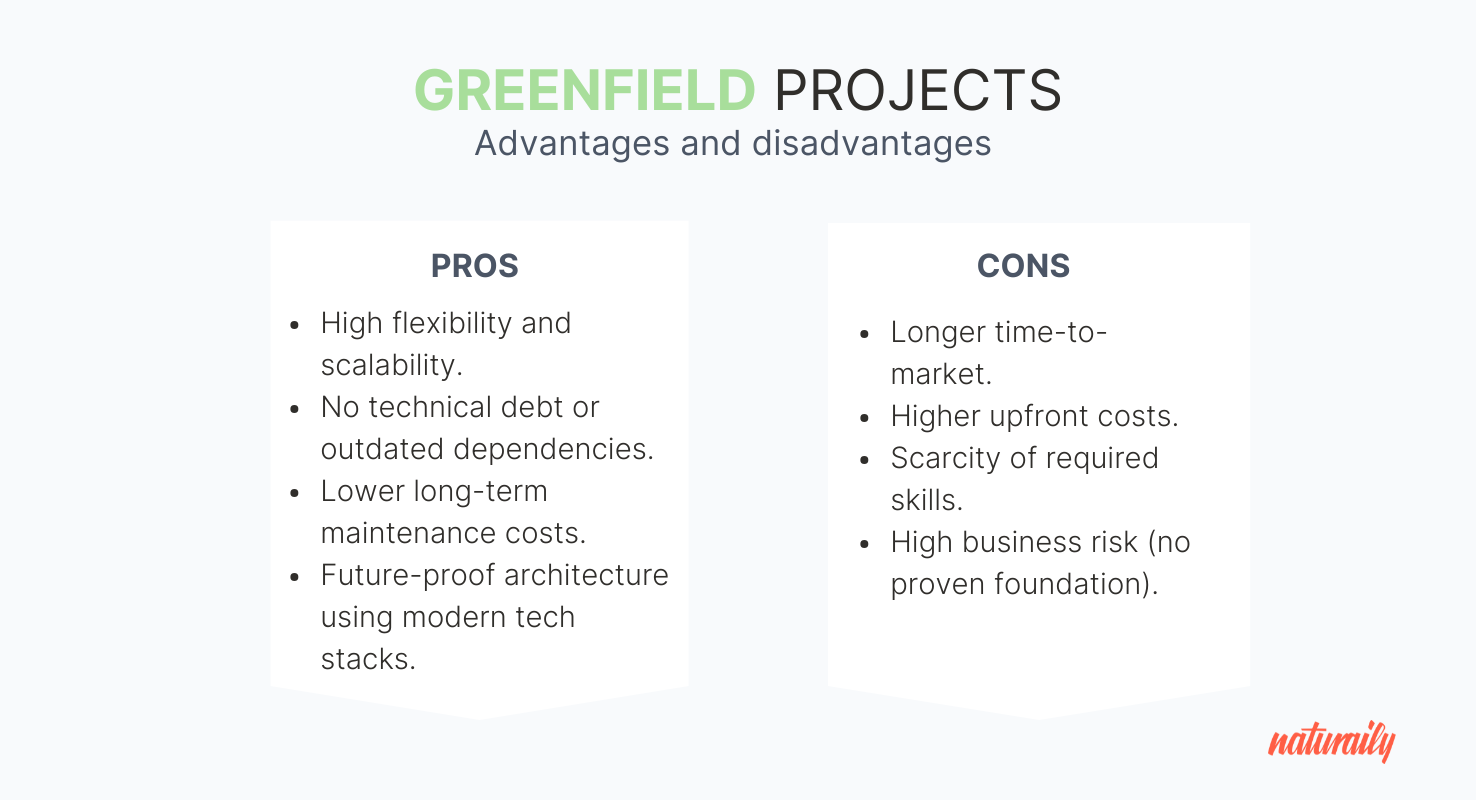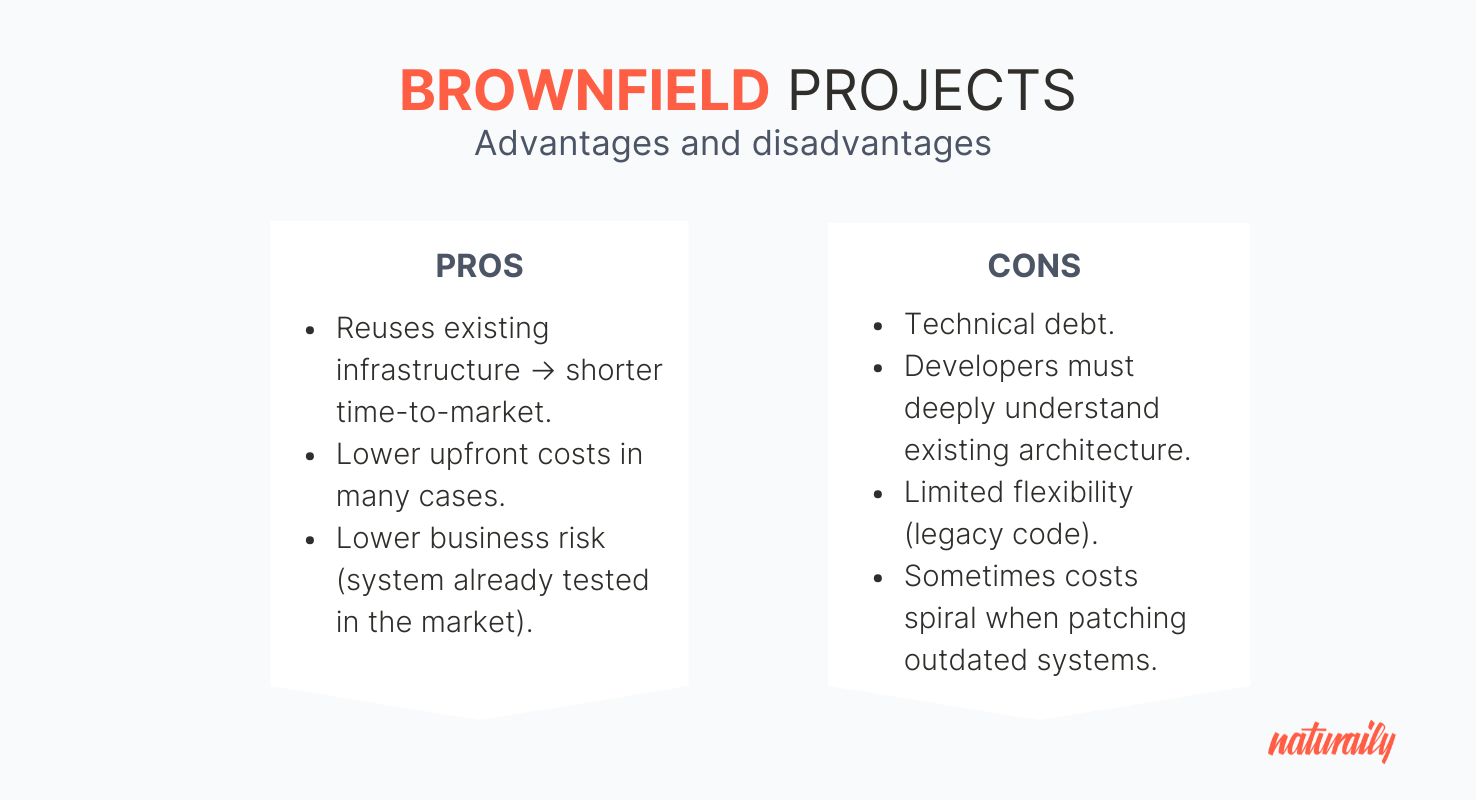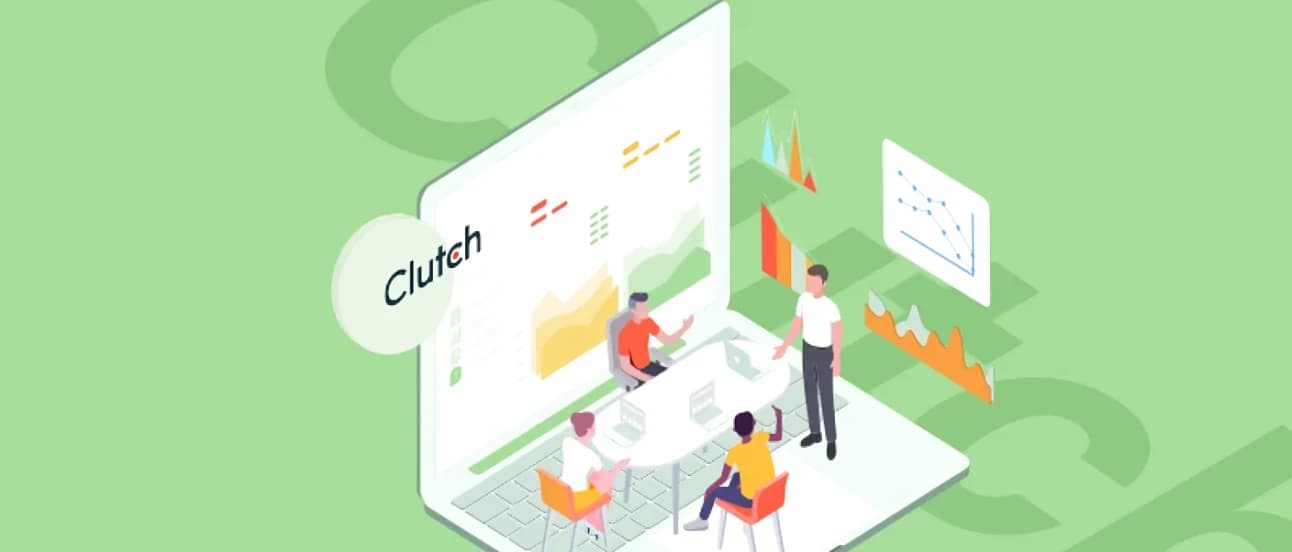Greenfield vs Brownfield IT Projects: Key Differences, Costs and Risks
Starting a project from scratch or taking an already started one – this is what the greenfield vs brownfield question is mainly about. It brings, however, a few important issues. How to run such projects? Which approach is better for your needs? What does the development process look like? Check the answers below.

In brief
Greenfield = Build from scratch → More flexibility, scalability, and innovation, but higher costs, longer time-to-market, and bigger risks.
Brownfield = Build on existing systems → Lower entry costs, shorter time-to-market, but limitations due to legacy code, technical debt, and integration challenges.
Decision framework: Choose greenfield when your existing system is outdated or misaligned with business goals. Choose brownfield when extending/modernizing legacy systems is feasible and cost-effective.
Key factors: ROI comparison, cost-benefit analysis, risk profile, industry-specific use cases, and stakeholder alignment.
Time to demystify greenfield and brownfield IT projects. The terms might be new for you, so let's start with the basics.
Both terms originally referred to direct investment. A company that decides to invest and chooses to build everything from the ground up, on a “green”, implicitly uncultivated field, can call this investment a “greenfield” one.
The “brownfield” investment, on the other hand, refers to a situation when a company builds upon already existing facilities or other resources, or even leases them, which means it operates on a field that’s been previously used and cultivated.
The same goes for IT projects – a greenfield project is a brand new one, developed from scratch, and not based on any existing systems, code or infrastructure, unlike a brownfield one, which is built upon already existing projects, code or other resources.
Read on to learn about:
The differences between greenfield vs brownfield projects
Pros & cons of greenfield projects
The project management process for both types
When to choose a greenfield approach or a brownfield project

Unlock the right path for your next IT project
Whether it is greenfield or brownfield, our experts will help you cut risks, optimize costs, and deliver a solution built for long-term growth.
Greenfield vs Brownfield in the IT Projects
Both approaches apply to many types of IT projects, such as software tools, apps, websites, networks, or IT facilities.
With brownfield, you might be adding a new management module to your existing CMS, integrating features into an e-store, or boosting an app's performance.
Greenfield projects give you more creative freedom and flexibility. The downside? Without clear business goals and a well-defined roadmap, it's easy to lose focus and let the scope spiral out of control.
The best way to manage this risk? Use agile methodology. It keeps communication flowing and helps you catch small issues before they become major problems.
Brownfield projects usually come with some constraints and limitations, but in this case, much of the groundwork is already done.
These differences matter when deciding how to launch your software, and we'll dive into specific use cases later.
Now, let's break down the pros and cons of each approach.
What’s Good About Greenfield Projects?
The advantages of greenfield projects stem directly from their nature.
The first one is flexibility. Since you're building from scratch to meet specific business needs, the solution fits perfectly, like custom web solutions should.
For the same reasons, greenfield solutions can be highly scalable.
The enhanced flexibility also means lower maintenance costs. There's no bloated legacy code, no unused features, and no duplicate functions eating up resources.
Greenfield IT projects tend to be more future-proof, because they are not limited by the constraints of outdated technologies and are free of redundant dependencies of old systems.
Everything uses current best practices and modern architecture, so no technical debt to slow you down.
See how we deliver web development solutions that empower you to grow
Learn more
What Are the Risks in Greenfield Development?
Building everything from scratch means longer time-to-market, and higher business risk, as you're creating one as you go.
You need to plan everything: business requirements, technology choices, system architecture, user interface design. Every choice is a potential bottleneck that could delay your project.
And yes, it gets expensive. Greenfield projects demand skills that are often scarce (and pricey), plus your users need training. Your team will need time to adapt, likely with help from outside experts.

| Benefits of greenfield projects: | Challenges of greenfield projects: |
|---|---|
| Strong adaptability and room for growth. | Longer development cycles before launch. |
| Free from legacy code or outdated systems. | Higher initial investment needed. |
| Reduced upkeep costs over time. | Limited availability of specialized talent. |
| Modern, future-ready architecture with up-to-date technologies. | Greater business uncertainty due to lack of a proven foundation. |
What Are the Advantages of Brownfield Projects?
Unlike greenfield projects, brownfield development follows an established direction and lets you reuse existing code for new features.
This typically means faster time to market and sometimes lower costs (though there are exceptions we'll cover shortly).
Risk decreases because you're working with proven systems. Users have already battle-tested the software, exposing potential problems and edge cases before you even start.
What Are the Challenges of Brownfield Software Development?
Brownfield's constraints can be painful. You're stuck with legacy code and technical debt, plus the existing features rarely align perfectly with what users actually need today.
The biggest hurdle? Understanding every detail of the current system. Developers who didn't write the original code face a steep learning curve, made worse by missing documentation and messy codebases.

And, sometimes, the end result isn’t really worth the effort of trying to patch the old software with new features, and the project may eventually be very time and resource-consuming.
| Benefits of brownfield projects: | Challenges of brownfield projects: |
|---|---|
| Makes use of existing systems → faster launch to market. | Legacy code and missing documentation can slow development. |
| Often requires less initial investment. | Teams need a strong grasp of the old architecture. |
| Reduced business risk (solutions already validated in real use). | Less room for innovation due to constraints of existing systems. |
Greenfield vs Brownfield: A Decision Framework
When choosing between greenfield and brownfield, use this decision matrix:
| Scenario | Recommended approach | Reasoning |
|---|---|---|
| Existing system works well but needs a few extra features (e.g., new payment method in an e-commerce platform). | Brownfield | Extending the current system is faster, cheaper, and less disruptive. |
| Existing system is outdated, poorly documented, or overloaded with technical debt. | Greenfield | Rebuilding from scratch provides a clean slate, removes technical debt, and creates a scalable foundation. |
| Startup launching a brand-new SaaS product in a competitive market. | Greenfield | Allows complete flexibility and ensures the product is tailored to business goals from the beginning. |
| Enterprise needs to modernize while ensuring minimal downtime (e.g., ERP or CRM with ongoing operations). | Brownfield with selective refactoring | Incremental improvements reduce risk of disruption while still improving performance. |
| Legacy system with critical security or compliance issues (e.g., healthcare or banking software). | Greenfield | Meeting compliance requirements often makes rebuilding the smarter investment. |
| Company expanding into new markets but wants to reuse parts of existing infrastructure (e.g., adding a regional site or app). | Hybrid Brownfield/Greenfield | Selective reuse of stable modules combined with greenfield components balances speed and scalability. |
| Short-term need to test a new feature or product idea (proof of concept or MVP). | Greenfield (MVP) | Starting from scratch enables faster iteration and validation without being slowed down by legacy code. |
| Enterprise system migration to cloud (e.g., moving on-premise legacy systems to AWS or Azure). | Depends on audit: Greenfield if legacy is outdated; Brownfield if system is stable | A code audit determines whether it’s cheaper and faster to rebuild or replatform. |
| Business wants to reduce licensing costs from outdated proprietary software. | Greenfield | Open-source or modern alternatives often require rebuilding instead of patching the old system. |
| Rapid feature competition (e.g., retail or e-commerce during seasonal peaks). | Brownfield | Extending existing platforms ensures faster time-to-market under tight deadlines. |

Cut risks, optimize costs, deliver better
Whether starting fresh or modernizing legacy systems, Naturaily helps you maximize ROI with tailored web development strategies.
How to Run Greenfield Software Development
A greenfield project offers the benefit of a fresh start and unlimited creativity, which is an opportunity that brings an equally significant challenge.
If you have an innovative idea for an online store and a defined budget, but lack developers or technical expertise, partnering with a software house or agency with proven e-commerce experience can be the solution.
Where should you begin? Start by sharing your vision with an agency experienced in executing similar projects. Their value extends beyond skilled developers, as they bring crucial knowledge of every step in the process that leads to business success.
With so many unknowns in greenfield development, nailing the preparation phase is everything. Here's the typical workflow:

Business analysis
In this stage, also known as the product design phase, we need to answer some important questions about the planned software.
These questions address the problem the product will solve, the user personas, the goals, and ultimately, the software's reason for existing in the first place.
Why is it important? According to Founders Forum Group, the single biggest reason for startup failure is creating products that don't address a real market need (42%).
42%
of startups fail because their products
don’t solve a real problem for the market.
Source
FF GroupSince this involves business and marketing analysis, you should include specialists from these areas. Workshops with brainstorming sessions that bring together both agency and client employees are particularly valuable at this stage.
If the answers to these questions aren't immediately clear, you should also conduct market and competition research.
Strategy
After analyzing everything, it's time to define the exact business model (including monetization methods and pricing) and choose a development approach for the software (including the right architecture, such as Jamstack, and the specific tech stack).
The strategy bridges business and development considerations, creating a coherent vision for every aspect of the product along with clear implementation paths.
Design
Once we have a strategy in place, we have to design the product. During this stage, the cooperation between the client and the agency should be very tight.
Design brings together logical, UX, and visual elements - all interconnected areas that can be developed simultaneously.
We need to map out user journeys and translate them into concrete steps that will be reflected in the final design.
Prototyping is another vital part of the design process, helping to determine the optimal user experience and test ideas. The prototype should be continuously reviewed, refined, and iterated based on feedback and requirements.
Development process
The final phase is development. The agency establishes a workflow, assembles a team of developers, and sets the project timeline.
The product is typically built in sprints, allowing for iterations and refinements throughout this stage.
A best practice is to create an MVP (minimum viable product) - a simplified version of the final software that includes only the essential features needed to launch in the market.
This is the general process for executing a greenfield project.
How to Run Brownfield Software Development
For brownfield projects, the path is slightly different.
The existing software we're building upon may be abandoned (created some time ago and no longer in use) or incomplete (only partially developed with unfinished components).
The first important step is understanding why the client wants to pursue a brownfield project. Usually, they assume it will cost less and take less time, but as mentioned earlier, that's not always the case.
After analyzing the existing code and new product requirements, you might discover that starting fresh with a greenfield approach would actually be faster and more cost-effective.
But let's assume we've weighed all the pros and cons and determined that a brownfield project is the most practical path forward.
Analysis of the existing project
The existing code may hold many surprises, so it needs thorough analysis to identify all weak points and outdated elements. It may make sense to reuse only part of the existing solution and discard the rest.
We should also analyze the product's history through original developer testimonies and documentation, understanding its past failures and initial goals, then comparing them with the new objectives.
This phase is time-consuming and often tedious. Sometimes it feels like detective work, but when done properly, it makes subsequent phases shorter and easier.
The result should be a comprehensive picture of all the technical, human, and organizational constraints in the system you're building upon.
Gap analysis
At this stage, we define how to bridge the gap between the existing and desired software. The questions we ask during this phase help us pinpoint the specific problems. Are the issues related to usability, performance, compliance, security, or aesthetics?
We should also compare the new requirements with the original ones and identify what has already been addressed.
Building a plan
With updated requirements in hand, we can create a project roadmap that prioritizes which features to implement first and which can be addressed later. Then we break this roadmap down into specific tasks.
Avoid the trap of rewriting everything to work better. Remember, you chose a brownfield project for a reason.
Rewriting code can also lead to technical problems, as new code might not be compatible with existing components.
Some tasks may prove more complex than anticipated, so build time and budget buffers into your plan.
Brownfield implementation
The final phase, as with greenfield projects, is development according to the predetermined agenda.
Remember to involve all stakeholders throughout the project. Without their input, the plan may fall apart. They should participate in requirements gathering, prototyping, and sprint demos.

Best Practices for Leading Greenfield and Brownfield Projects
| For greenfield | For brownfield |
|---|---|
| 1. Conduct deep business analysis (problem validation, user personas, ROI). | 1. Start with a thorough code & system audit. |
| 2. Use agile methodology for flexibility. | 2. Perform a gap analysis (new vs old requirements). |
| 3. Build an MVP first. | 3. Prioritize features → roadmap. |
| 4. Involve both business and tech stakeholders early. | 4. Account for time & budget buffers (hidden costs often arise). |
Practical Greenfield and Brownfield Case Studies
Greenfield project (SaaS)
Case study: n8n, a company for workflow automation, needed a completely new web solution to support their rapid growth. Naturaily built a scalable Jamstack architecture with Nuxt.js, integrated multiple APIs, and implemented hybrid rendering with caching strategies. The new infrastructure empowered their marketing team to scale content creation without constant developer support.
The results?>300% higher monthly organic traffic in two years, a 900% increase in Top 10 keywords, and Core Web Vitals hitting 100. With a lightning-fast, SEO-optimized platform, n8n transformed its website into a growth engine for its SaaS business. Here you can read a full n8n case study.
Brownfield project example (Shopify development)
Nerdy Banana, a UK-based digital and e-commerce agency, came to us with Shopify stores that relied on manual processes for product customization and order fulfillment. The lack of automation slowed delivery times and limited growth potential.
We modernized their existing setup by building a custom Shopify app that automated print file generation, streamlined order processing, and introduced a live product configurator for customers. The solution reused Shopify’s infrastructure but extended it with new features — a classic brownfield approach.
The production lead time dropped by 95% (from 48 hours to 5 minutes), delivery times shortened from 5 days to just 1, and conversion rates grew from 3.6% to 4.9%. Read a full Nerdy Banana case study.
Brownfield project case study (financial industry)
Capitalise, a UK-based financial services company, was held back by an outdated Pimcore system that made content editing slow, hurt site performance, and limited SEO growth. To overcome these challenges, they partnered with Naturaily for a software replatforming initiative.
We migrated Capitalise to a headless architecture with Storyblok CMS and Next.js, empowering content editors with a flexible, visual interface while significantly boosting performance and SEO.
Capitalise’s team can now create and manage content independently, test new ideas with data-driven insights, and deliver a seamless user experience on a fast, scalable platform. More: Capitalise case study.
Should I Choose a Greenfield or Brownfield Development?
What matters most is making this choice based on a careful cost-benefit analysis and alignment among all stakeholders from your internal team to the software house you partner with.
At Naturaily, we help companies navigate this decision every day, whether it’s through greenfield builds, brownfield modernization, or hybrid approaches that combine the best of both. From Jamstack and Next.js development to custom SaaS platforms and e-commerce solutions, we know how to guide projects from concept to market success.
FAQ
Questions and Answers
Kickstart your greenfield or brownfield project today
From strategy to implementation, Naturaily will guide you through every step with clarity and confidence.


